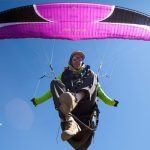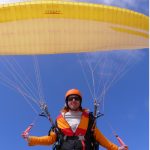Understand the Spiral Dive in paragliding
The spiral dive is not really an accurate trick but one of the most essential manoeuvres to learn since it's the best height losing manoeuvre. Together with the food stall, these are the two most important manoeuvring skills for general safety in paragliding.
During a fast spiral dive, the pilot is at the same level as the glider, the leading edge is facing the ground and is about parallel with the horizon. The pilot turns very fast around the centre of the rotation and the sink rate can reach over 20 meters per second.
Dealing with the G-Force in a spiral dive
Because the movement is continuous and the speed of rotation is high, the centrifugal forces on the pilot are the most inconvenient of all manoeuvres in paragliding, even though the g-forces can peak much higher in an asymmetric tumbling but only for short moments and therefore it's a lot easier to handle.
To be able to keep a deep spiral going for a longer period of time it is necessary to breathe and tension the muscles in the correct way that prevents the blood from leaving the head, which could ultimately lead to loss of sight or blackout. I will tell you more about this later.
It is extremely important to learn this manoeuvre progressively; this will be our first experience with higher g-forces and the body needs to get used to it. In the beginning, even a steep turn might become pretty uncomfortable but we just have to keep practising and our feeling will quickly improve.
The other reason why we need to progress step by step is the exit, the most technical part of the manoeuvre. The more speed there is in the spiral the higher the amount of energy that we have to deal with. When exiting, coming out from the rotation with too much energy can cause troubles.
Entering your paraglider in a spiral dive
Preparation: Set the harness to a highly upright position. This is important so that the g-forces run more parallel with the spine otherwise. It will be really hard to keep our head up and this could even lead to a neck injury. Open the chest strap as wide as possible to make the harness more sensitive for weight shifting and to reduce the risk of riser twists. Always use a regular sitting harness to learn all manoeuvres and never a pod harness.
Entering a spiral dive is fairly simple: shift your weight to one side and carefully start to apply the brake on that side. The paraglider starts to turn and accelerates. First, we will see the wingtip approaching the horizon picking up more and more speed, the angle between the horizon and the leading edge will decrease and ultimately the wing will face the ground completely. This is called a nose-down spiral and it is the position of maximum sink rate.
The faster the turn the higher the brake pressure will be. Entering the spiral needs gentle and progressive braking but to maintain a certain speed and sink rate we will not have to hold down the brake that deep anymore; once reaching the desired speed we have to release some brake to maintain the same rotation. How much exactly? that depends: if it's only a steep turn which is not so fast then we have to keep braking actively, but if the angle drops down more we need to come back higher up with the inside brake.
In a nose-down spiral, just a little touch or even no break at all will be enough to keep going. In this case, your body will feel very heavy, you can now centre yourself in the harness to be in a neutral position. If we are nose-down and the outside wingtip closes or flattens it means that we are definitely braking too much on the inside breaking. A lot in this position will not increase the sink rate, in fact not having the wing all the way open will even slow down the rotation.
For maximum sink rate, we have to let doing fly as fast as possible with as little inputs as possible. On the other hand, if we notice that the spiral starts to slow down but we want to keep going a steering input on the inside will be necessary.
When turning at higher speeds, short kicks on the brake are a great way to adjust the speed or to initiate the exit. It is actually the exit that needs the most practice to master this manoeuvre.
When descending at high speeds there is an incredible amount of energy in the movement, we have to learn how to control this and bleed out the energy in a gradual and safe way.
The exit: how to stop a spiral dive in paragliding
Thanks to the high cross stability of the paraglider designs, theoretically, by centring yourself and releasing the brake, the glider should automatically slow down and exit from the spiral by itself within a couple of turns. However, the theory does not always apply to practice and, anyway, this process may take way too long while the ground is coming really fast at you.
Learning how to exit actively in a controlled way we not only make the spiral safer but will also allow us to exit at much lower heights that can win precious moments when reaching the ground is urgent.
I speed up the exit process in the two stages: first, slowing down, and second, killing the remaining energy.
In this first stage of the exit, start slowing the rotation down. We achieved this through counter-steering with the break and weight shifting. The more energy there is in the turn the harder the counter-steering impose needs to be to initiate a fast enough exit.
Let's take a look at different scenarios, depending on the speed of the turn.
As long as the angle between a leading edge of the horizon is still wide open, let's say up to 45 degrees. I call this a steep turn or moderate spiral. The sink rate here is around five to ten meters per second. It is usually enough to simply release the inside break completely, centre your body in the harness and the rotation will start to slow down automatically.
Maybe we can help it by some counter-steering until we start to feel the speed decreases. We don't necessarily have to release the inside break all the way up but work with both breaks at the same time.
Another scenario, a nose-down spiral: the angle between the leading edge of the horizon is closing and the sink rate can reach up to 20 meters per second or more.
We need a short but strong counter-steering input to initiate the exit rapidly enough. This means releasing the inside brake white shifting and braking to the outside of the turns until we feel at the speed of rotation and the g-forces start to drop, but as soon as you feel that the rotation is slowing down you don't keep on contesting for too long, otherwise, you might initiate a dangerous counter turn.
Once the speed of rotation starts to drop it means that you managed to start the exit process: now, we have to focus on killing the remaining energy in a controlled way.
Exiting too quickly with too much energy can cause a violent climb followed by a powerful surge. A bad reaction here can end up in a stall or a big collapse. Exiting too slow is, of course, safer but this can burn too much attitude that we often cannot afford to lose when already closer to the ground.
This is why it's so important to learn how to deal with the remaining energy safely. We have to slow down the rotation gradually so that the angle between a leading edge and the horizon starts to increase again coming back to a 45-degree angle.
When this start to happen we usually don't need more counter-steering inputs; Center your body and touch both brakes gently. To feel and control the glider better, looking at the inside wingtip. Our goal is to arrive in an angle where the tip is still touching the horizon and the wing is at a 45-degree angle. Keep the wing in this position for a few turns.
You may need to apply a combination of gentle inside brake and weight shifting to keep the window. Once you can feel that the extra speed and energy of the spiral is gone, return to straight slide just like from a regular tight turn.
Quick spiral exit
Quick spiral exit in a real situation when we have to go down fast and there is no time to waste being able to safely spiral to low altitudes and that exit rapidly in a controlled way is a must-have skill for all paraglider pilots.
Most of you surely already experienced the big climb and surge when exiting a spiral unclean. This can become very dangerous. We need to transform the remaining energy into a climbing turn instead of a violent straight-up climb.
Initiate the exit by countersteering the same way as described earlier. Just before swinging back underneath the wing, we need to move back to the inside with our weight and pull the inside brake to keep the wing in the turn until the energy is gone.
You can start hands up leading it out with weight shift maybe a little bit of outside break and now come back to the right.
Put some rights on eyes, that's the way you hear the energy sideways. It needs a bit of practice to catch the right moment and pull the right amount, but you will be surprised how smooth and gentle the exits will become.
Dangers when spiral dive in paragliding
Be careful not to be too aggressive on the brake when accelerating into the turn because it's possible to spin the glider. Use weight shifting actively to support the brake inputs. This way it won't be necessary to force the wing too much by braking.
Be aware that being light on a wing we lose speed and handling so being on the lower end of the weight range we need to be even more careful by entering, never force the glider too much into the turn exit.
Coming out of the turn with too much speed, without bleeding the energy out sideways will lead to a violent climb. We should not break at all at this moment while the glider is behind as this we made the situation even worse and we might even stall the glider. This moment may feel pretty scary as well because we will not have airspeed at all.
After this, the wing starts to shoot forward and we need to stop it in front by braking. Watch which side of the wing we search forward first as this we rarely happen in a symmetrical way.
Coming out from the turn: if one half of the wing is diving out first you need to break this side more. Otherwise, it will collapse and could cravat. but remember that a moment ago we were really close to the stall point and the wing needs to recover from that by picking up some speed first. If we start to brake too hard too early, there is a high risk of stalling the paraglider.
Attempting to spiral for a longer period of time: it's important to prevent the blood from flowing down the body from the very beginning. We need to strengthen the lower body muscles like the legs of the belly and bottom. This creates a natural gait and prevents the blood from flowing down to the tip of the feet which will be very painful. The correct breathing is just as an important simple way is to quickly breathe in one rhythm and read out three rhythms with pressure. Something like these two things will help you to stay in focus and handle the force as well.
Acro wings: Due to the much higher wing loading, it needs a lot less effort and inputs to enter and control the spiral. With some, it is even possible by wide shifting only. The
spiral will be a great speed taking manoeuvre to enter.
Some of the most radical tricks, such as the tumbling, to do so we don't actually accelerate in the stable deep spiral but just enter it quickly and progressively and then instantly begin with the exit process when the leading edge closes down to the horizon. This is the quickest way to gain maximum power with as little height loss as possible.
Key points
Enter progressively with weight shift and brake.
Progress step by step into faster rotations, no big climbs on exit.
Learn to kill the energy in a flat turn, focus on fast but clean exits.
This post is a transcription of the Video "MASTER ACRO - Spiral Dive (free episode)" by Pal Takats














